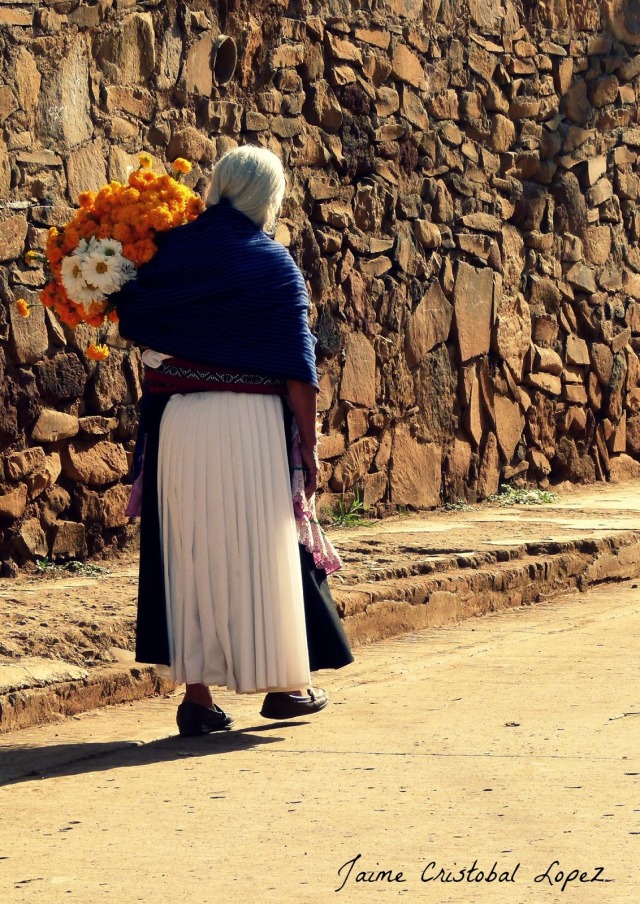Today is a very special day in Mexico. The whole country dresses in vivid colors of red, blue, yellow, pink, green, even black and white. The smell of copal is everywhere in the mercado —the open-air markets found in many cities throughout Mexico—along with the sweet smell of candied camote and calabaza or crystalized sweet potato with pumpkin. The fragrant smell of the flor de cempasúchil and flor de terciopelo, combined with the sweet smell of the food coming from street vendors, is just one of a kind.
This time of the year, I miss Mexico the most. Although I enjoy the changing of seasons in the East Coast and Midwest, and the festivities that come with it, spending Día de los Muertos in Mexico is a very special and unforgettable experience.
In Mexico, Día de los Muertos is a special six-day festivity where families set up special altars in honor of their family members who have passed away. In each house, ofrendas are placed on altars intended to welcome them back amongst the living. The ofrendas are collections of objects that held some type of significance to the dearly departed while they were still alive.


El Día de los Muertos is a very misunderstood cultural tradition from Mexico, Central, and South America. Its roots originate amongst the many native tribes that lived in the continent prior to the arrival of the Europeans. Even the Spanish priests who came to America during the Conquista did not fully understand this concept of honoring dead relatives.
There are tons of articles and books written about this stigmatized and misunderstood holiday, but the more we read them the more confused the person trying to learn about can become. I believe this is because it is hard to be able to explain spirituality within Native American cultures to someone in the outside who did not grow up in it. As a result, people judge both the culture and the people who practice such traditions.
Although pre-Hispanic practices of Día de los Muertos have changed greatly throughout the ages, the essence of this special holiday has not changed; taking time to remember the relatives who are no longer on this earth.
As much I would like to be able to travel to Mexico during this special day, to be able to eat, smell, see, touch, and hear the festivities that take place during Día de los Muertos, I currently can’t. So instead, I do what I can to educate my family about this part of my culture, sharing with them all the things they are missing by growing up elsewhere.
I prepare special sweets, desserts, and drinks that resemble the smells of the mercados in Mexico during this time of the year. I take out pictures of my family members from Mexico who are no longer with us. I share anecdotes about them and explain to my daughters how much they meant to me.
I light up a candle and say a prayer for them.
I don’t want to ever forget them and it is my duty that my children learn who those special people in my life were.
This year, my cousin from Mexico sent me pictures of the colorful altars set up by the local government in the city of San Luis Potosi, where I am originally from. Many cities in Mexico set up similar altars in their respective Historic centers. The altars set up in Mexico City, Oaxaca and Michoacán are the most famous. San Luis Potosi sets up altars throughout the Historic Downtown of the city. They are very striking and interesting to see.



Other places to visit during Día de los Muertos are the cemeteries, which are full of life during this time of the year. Cemeteries are usually depicted as creepy, dark and gloomy in Hollywood movies, but in Mexico this is the opposite during Día de los Muertos. The whole cemetery comes alive during November 1 and 2, the official days of Día de los Muertos.
Entire families go to the cemetery and spend the whole night or nights at the grave of their dead relatives. They light up candles, take beautiful flower ornaments, and take food to eat with their families while they stay up all night praying and thinking of their long-gone relatives.
It is beautiful to experience this.
This year I will be making a special place today to remember my stepdad who passed away this year on April. It was his wish before he passed away to be able to go back to Mexico to spend time with his relatives.
Feliz Día de los Muertos to those who celebrate this holiday!


